Archival ALMA data have confirmed that molecules of vinyl cyanide reside in the atmosphere of Titan, Saturn’s largest moon. Titan is shown in an optical (atmosphere) infrared (surface) composite from NASA’s Cassini spacecraft. In a liquid methane environment, vinyl cyanide may form membranes.
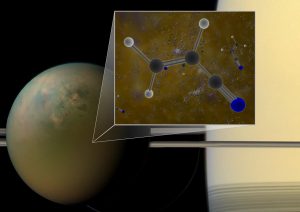
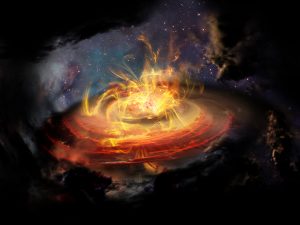
Chaotically Magnetized Cloud Is No Place to Build a Star, or Is It?
For decades, scientists thought that the magnetic field lines coursing around newly forming stars were both powerful and unyielding, working like jail bars to corral star-forming material. More recently, astronomers have found tantalizing evidence that large-scale turbulence far from a nascent star can drag magnetic fields around at will. Now, a team of astronomers using the Atacama Large Millimeter/submillimeter Array (ALMA) has discovered a surprisingly weak and wildly disorganized magnetic field very near a newly emerging protostar, shown here in an artist’s impression. These observations suggest that the impact of magnetic fields on star formation is more complex than previously thought.
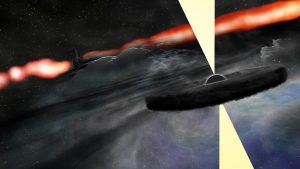
Artist’s Conception of Cygnus A’s Companion
Artist’s conception of newly-discovered secondary supermassive black hole orbiting the main, central supermassive black hole of galaxy Cygnus A.
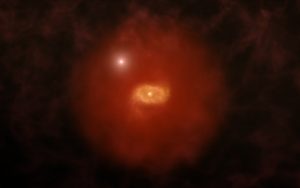
Illustration of a High Redshift Galaxy
Artist impression of a progenitor of Milky Way-like galaxy in the early universe with a background quasar shinning through a ‘super halo’ of hydrogen gas surrounding the galaxy. New ALMA observations of two such galaxies reveal that these vast halos extend well beyond the galaxies’ dusty, star-forming disks. The galaxies were initially found by the absorption of background quasar light passing through the galaxies. ALMA was able to image the ionized carbon in the galaxies’ disks, revealing crucial details about their structures.

DeeDee’s Orbit
Orbits of objects in our solar system, showing the current location of the planetary body ‘DeeDee’.
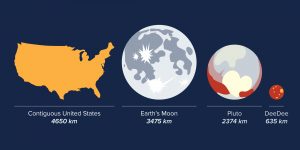
Size of DeeDee
Size comparisons of objects in our solar system, including the recently discovered planetary body ‘DeeDee.’





